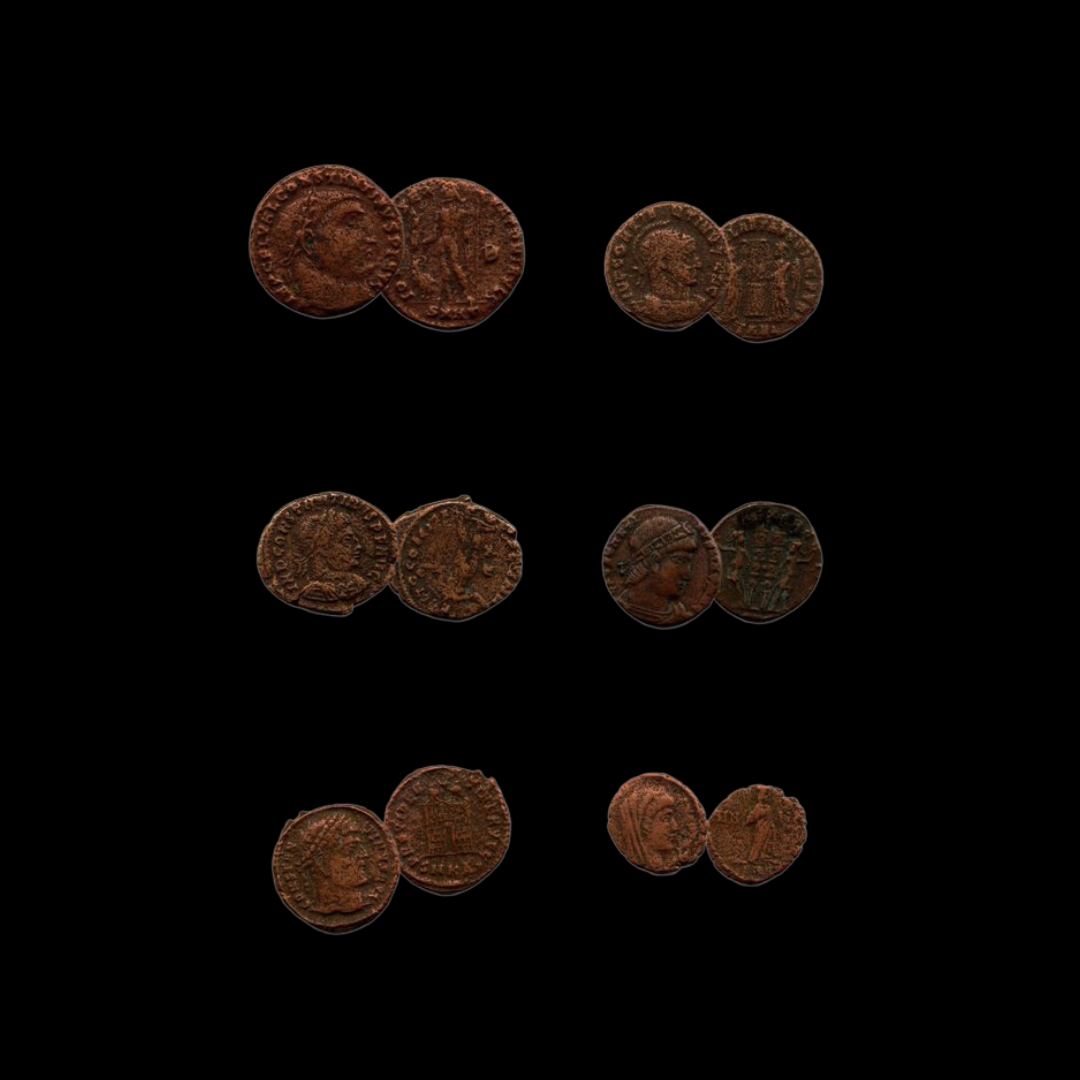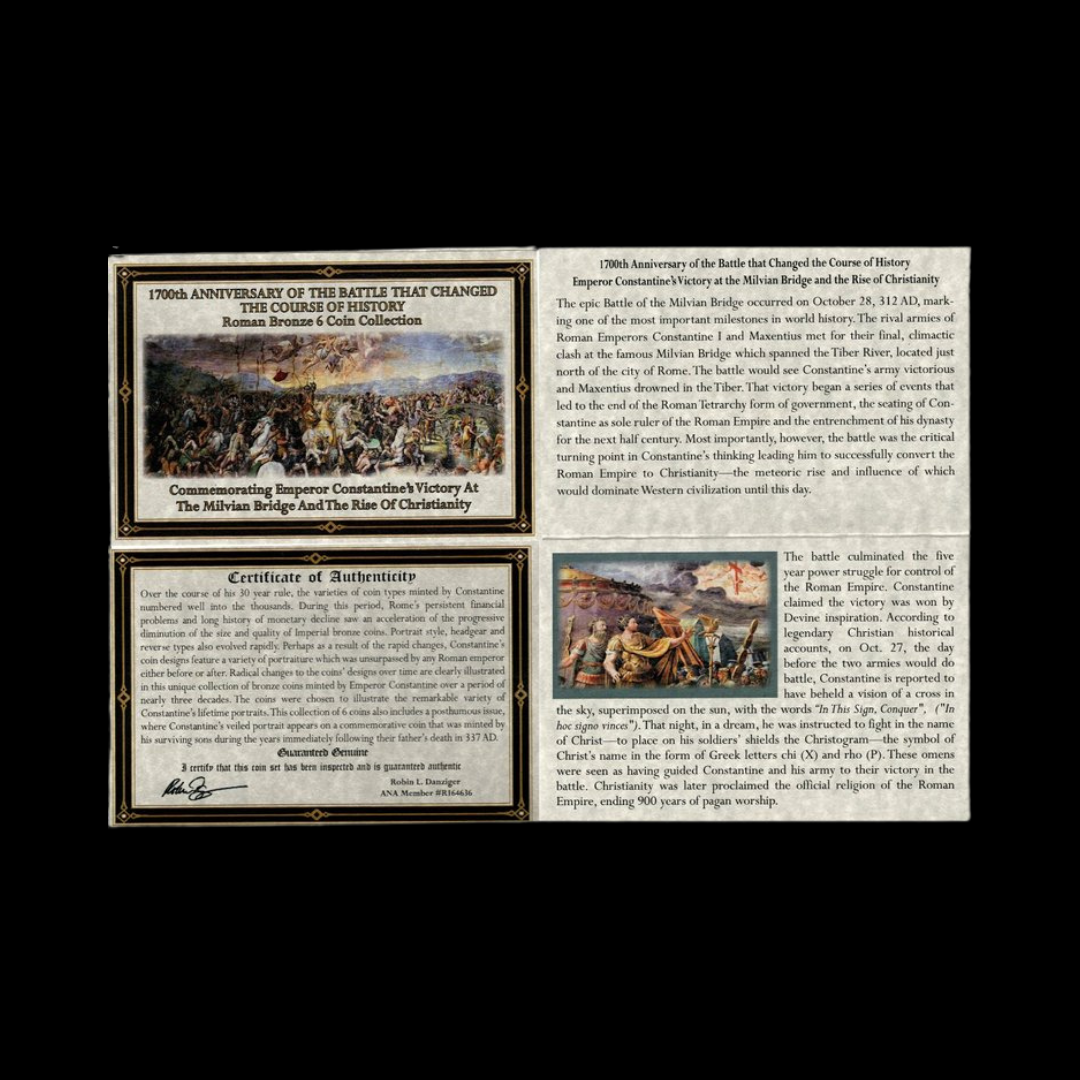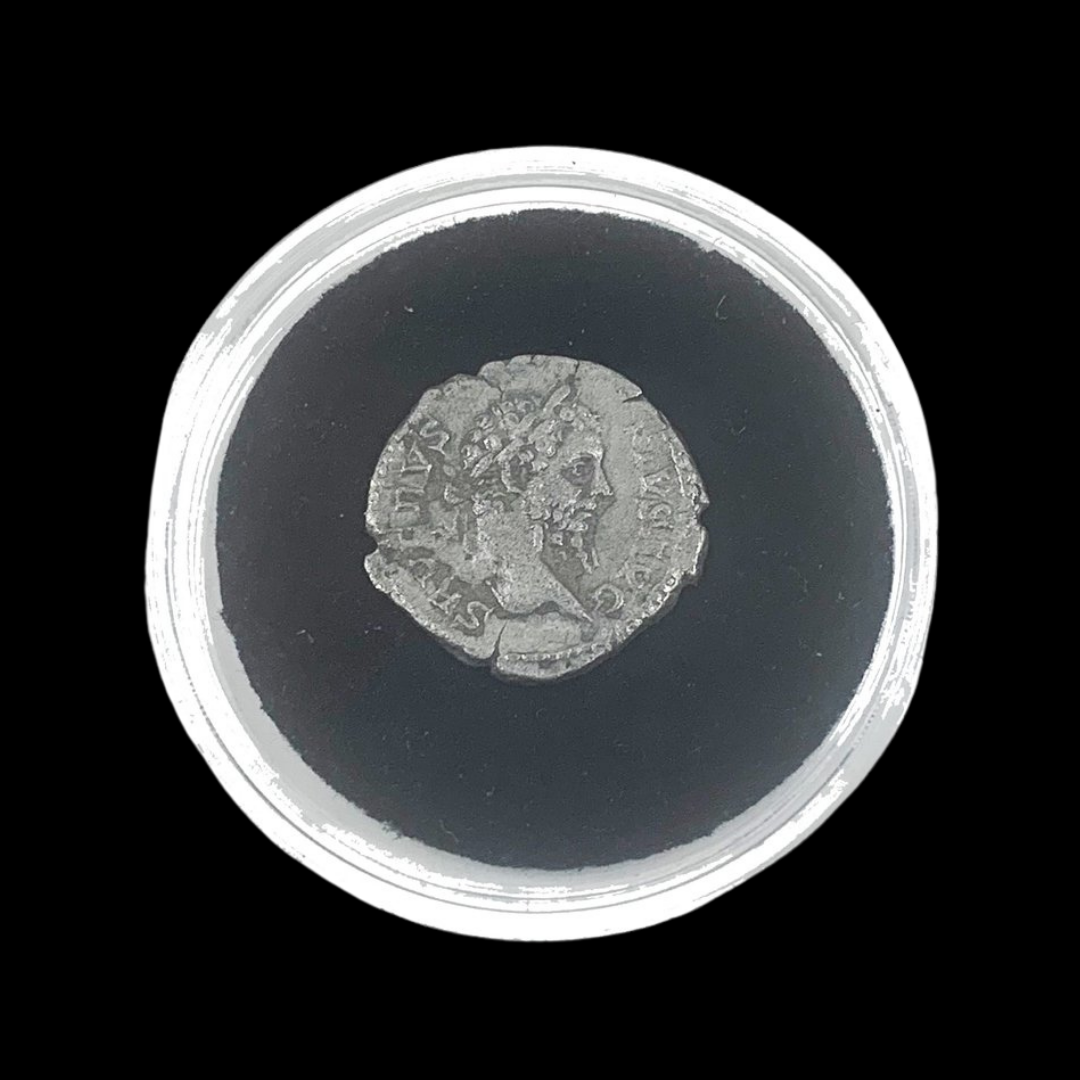 Image 1 of 2
Image 1 of 2

 Image 2 of 2
Image 2 of 2



The World of Antiquity: Six Coins from Ancient Times
This collection spans the rich tapestry of Classical antiquity (approximately 750 BCE to 476 CE), a formative period that laid the foundations for Western civilization through advancements in law, art, language, philosophy, and more. These six coins represent diverse cultures and kingdoms that flourished during this transformative era.
1. Chinese Ant Nose Money (about 2500-2200 years ago)
This distinctive bronze coin was produced during China's turbulent Warring States period when multiple kingdoms competed for power before China's imperial unification.
Coin Description:
Front side: Distinctive raised shape resembling an ant's nose or snout
Back side: Typically plain or with minimal markings
Technical Details:
Bronze composition
Zhou currency unit
Date/period: Warring States period, ca. 475-221 BCE
Historical Significance: This unusual currency circulated during a time of political fragmentation in ancient China when seven major states competed for dominance. These distinctive coins represent an important transitional phase in Chinese monetary history before the Qin Dynasty unified China's currency system in 221 BCE.
2. Seleucid Empire Bronze Drachm (about 2300-2100 years ago)
This bronze coin was issued by the Seleucid Empire, one of the major Hellenistic kingdoms that emerged after Alexander the Great's death.
Coin Description:
Front side: Likely depicts the profile of a Seleucid king wearing a diadem (royal headband)
Back side: Possibly shows Apollo seated on an omphalos (sacred stone), holding a bow
Technical Details:
Bronze composition
Drachm denomination
Date/period: 312-63 BCE
Historical Significance: The Seleucid Empire represented the continuation of Greek culture across Western Asia following Alexander's conquests. Their coinage blended Greek artistic traditions with local elements, serving both as currency and propaganda displaying royal authority.
3. Greco-Bactrian Copper Drachm (about 2200-2100 years ago)
This copper drachm comes from the Greco-Bactrian Kingdom, a fascinating fusion of Greek and Central Asian cultures that flourished in what is now Afghanistan.
Coin Description:
Front side: Likely portrays a Greco-Bactrian king with distinctive features and royal diadem
Back side: Possibly depicts a Greek deity like Athena or Zeus, with Greek inscriptions
Technical Details:
Copper composition
Drachm denomination
Date/period: 240-140 BCE
Historical Significance: The Greco-Bactrian Kingdom represented one of history's most remarkable cultural fusions, where Greek colonists established a sophisticated civilization in Central Asia. Their coinage is renowned for exceptional artistic quality and documents the easternmost extent of Hellenistic influence.
4. Judaean Bronze Prutah from Herod Agrippa's Reign (about 1980-1987 years ago)
This small bronze coin was minted during the reign of Herod Agrippa I, who ruled Judaea as a client king under Roman authority.
Coin Description:
Front side: Likely shows symbols of royal authority such as a canopy (umbrella) or ears of barley
Back side: Probably displays the year of reign and inscription referencing "King Agrippa"
Technical Details:
Bronze composition
Prutah denomination (small everyday coin)
Date/period: 37-44 CE
Historical Significance: This coin circulated during a critical period in Jewish history, shortly after the time of Jesus. Herod Agrippa I was generally popular with his Jewish subjects and respected religious traditions, balancing Jewish sensibilities with Roman imperial authority.
5. Kushan Empire Bronze Tetradrachm of King Vima Takto (about 1950-1900 years ago)
This bronze tetradrachm was issued during the reign of King Vima Takto (also known as Soter Megas or "Great Savior"), an important ruler of the Kushan Empire.
Coin Description:
Front side: Likely shows the king on horseback or standing, with royal insignia
Back side: May depict various deities from the diverse Kushan pantheon
Technical Details:
Bronze composition
Tetradrachm denomination
Date/period: 55-101 CE
Historical Significance: The Kushan Empire controlled critical sections of the Silk Road trading routes connecting China, India, and Rome. Their coinage reflects their role as cultural intermediaries, incorporating artistic and religious elements from multiple civilizations.
6. Roman Bronze Coin from Emperor Gallienus's Reign (about 1770-1750 years ago)
This bronze coin was minted during the troubled reign of Emperor Gallienus, during the Crisis of the Third Century.
Coin Description:
Front side: Portrait of Emperor Gallienus wearing a radiate crown, with Latin inscription
Back side: Likely depicts a Roman deity or personification with accompanying Latin legends
Technical Details:
Bronze composition
AE (Aes) denomination
Date/period: 253-268 CE
Historical Significance: This coin was produced during one of Rome's most challenging periods, when the empire nearly collapsed. Gallienus implemented significant military reforms and was the first emperor to completely exclude senators from military commands, helping preserve the empire despite territorial losses.
This collection spans the rich tapestry of Classical antiquity (approximately 750 BCE to 476 CE), a formative period that laid the foundations for Western civilization through advancements in law, art, language, philosophy, and more. These six coins represent diverse cultures and kingdoms that flourished during this transformative era.
1. Chinese Ant Nose Money (about 2500-2200 years ago)
This distinctive bronze coin was produced during China's turbulent Warring States period when multiple kingdoms competed for power before China's imperial unification.
Coin Description:
Front side: Distinctive raised shape resembling an ant's nose or snout
Back side: Typically plain or with minimal markings
Technical Details:
Bronze composition
Zhou currency unit
Date/period: Warring States period, ca. 475-221 BCE
Historical Significance: This unusual currency circulated during a time of political fragmentation in ancient China when seven major states competed for dominance. These distinctive coins represent an important transitional phase in Chinese monetary history before the Qin Dynasty unified China's currency system in 221 BCE.
2. Seleucid Empire Bronze Drachm (about 2300-2100 years ago)
This bronze coin was issued by the Seleucid Empire, one of the major Hellenistic kingdoms that emerged after Alexander the Great's death.
Coin Description:
Front side: Likely depicts the profile of a Seleucid king wearing a diadem (royal headband)
Back side: Possibly shows Apollo seated on an omphalos (sacred stone), holding a bow
Technical Details:
Bronze composition
Drachm denomination
Date/period: 312-63 BCE
Historical Significance: The Seleucid Empire represented the continuation of Greek culture across Western Asia following Alexander's conquests. Their coinage blended Greek artistic traditions with local elements, serving both as currency and propaganda displaying royal authority.
3. Greco-Bactrian Copper Drachm (about 2200-2100 years ago)
This copper drachm comes from the Greco-Bactrian Kingdom, a fascinating fusion of Greek and Central Asian cultures that flourished in what is now Afghanistan.
Coin Description:
Front side: Likely portrays a Greco-Bactrian king with distinctive features and royal diadem
Back side: Possibly depicts a Greek deity like Athena or Zeus, with Greek inscriptions
Technical Details:
Copper composition
Drachm denomination
Date/period: 240-140 BCE
Historical Significance: The Greco-Bactrian Kingdom represented one of history's most remarkable cultural fusions, where Greek colonists established a sophisticated civilization in Central Asia. Their coinage is renowned for exceptional artistic quality and documents the easternmost extent of Hellenistic influence.
4. Judaean Bronze Prutah from Herod Agrippa's Reign (about 1980-1987 years ago)
This small bronze coin was minted during the reign of Herod Agrippa I, who ruled Judaea as a client king under Roman authority.
Coin Description:
Front side: Likely shows symbols of royal authority such as a canopy (umbrella) or ears of barley
Back side: Probably displays the year of reign and inscription referencing "King Agrippa"
Technical Details:
Bronze composition
Prutah denomination (small everyday coin)
Date/period: 37-44 CE
Historical Significance: This coin circulated during a critical period in Jewish history, shortly after the time of Jesus. Herod Agrippa I was generally popular with his Jewish subjects and respected religious traditions, balancing Jewish sensibilities with Roman imperial authority.
5. Kushan Empire Bronze Tetradrachm of King Vima Takto (about 1950-1900 years ago)
This bronze tetradrachm was issued during the reign of King Vima Takto (also known as Soter Megas or "Great Savior"), an important ruler of the Kushan Empire.
Coin Description:
Front side: Likely shows the king on horseback or standing, with royal insignia
Back side: May depict various deities from the diverse Kushan pantheon
Technical Details:
Bronze composition
Tetradrachm denomination
Date/period: 55-101 CE
Historical Significance: The Kushan Empire controlled critical sections of the Silk Road trading routes connecting China, India, and Rome. Their coinage reflects their role as cultural intermediaries, incorporating artistic and religious elements from multiple civilizations.
6. Roman Bronze Coin from Emperor Gallienus's Reign (about 1770-1750 years ago)
This bronze coin was minted during the troubled reign of Emperor Gallienus, during the Crisis of the Third Century.
Coin Description:
Front side: Portrait of Emperor Gallienus wearing a radiate crown, with Latin inscription
Back side: Likely depicts a Roman deity or personification with accompanying Latin legends
Technical Details:
Bronze composition
AE (Aes) denomination
Date/period: 253-268 CE
Historical Significance: This coin was produced during one of Rome's most challenging periods, when the empire nearly collapsed. Gallienus implemented significant military reforms and was the first emperor to completely exclude senators from military commands, helping preserve the empire despite territorial losses.

















